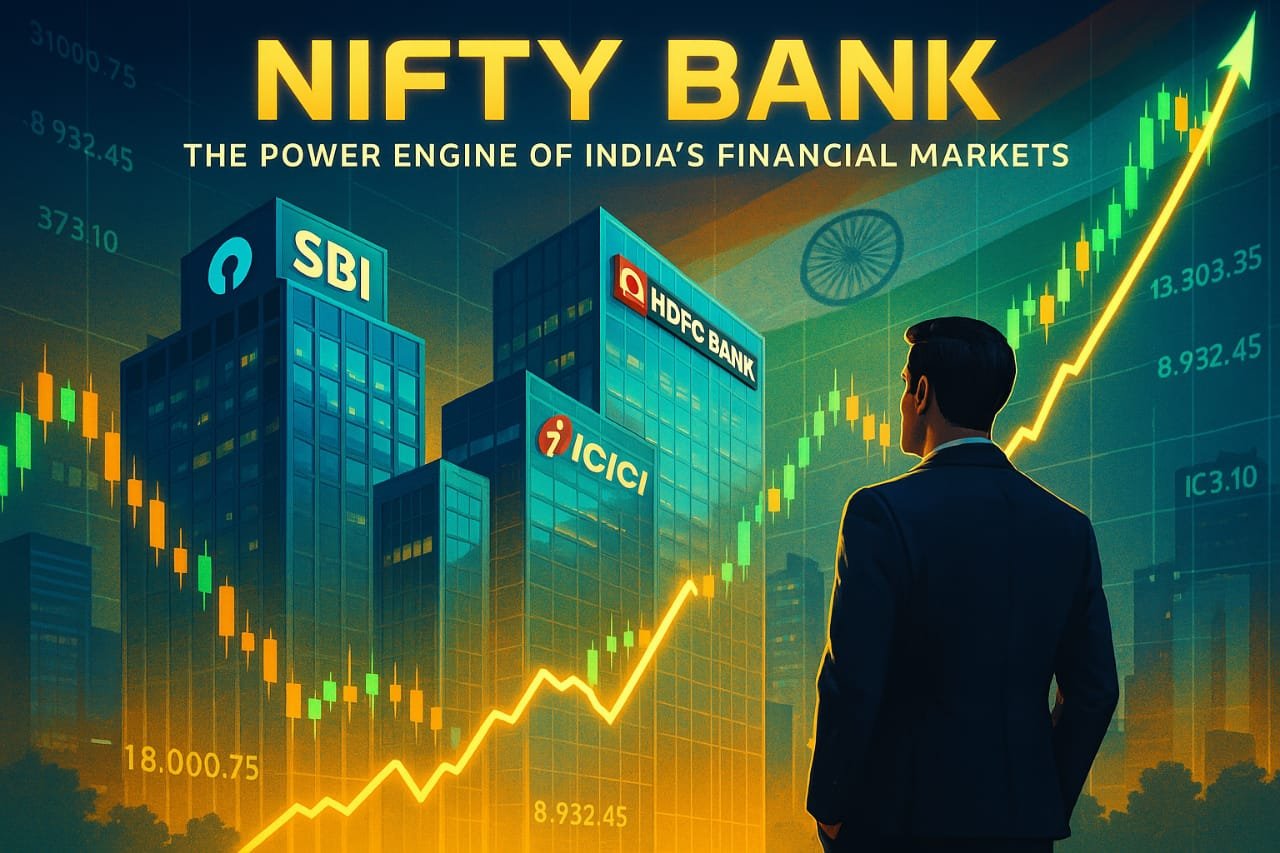Nifty Bank: The Power Engine of India’s Financial Markets
Banking is the backbone of any economy, and in India, Nifty Bank represents the pulse of this critical sector. Whether you’re a retail investor, a market enthusiast, or a financial planner, understanding Nifty Bank can give you a significant edge in reading the market’s temperature and making smarter investment decisions.

But why is this index so powerful? How does it compare with broader benchmarks like Nifty 50? And what trends should you be watching? Let’s break it down in this detailed, insight-packed blog post.
What is Nifty Bank?
The Nifty Bank Index is a sectoral index on the National Stock Exchange (NSE) of India that tracks the performance of the top 12 most liquid and large capitalized banking stocks listed on the exchange. It includes both public and private sector banks, such as:
-
HDFC Bank
-
ICICI Bank
-
State Bank of India (SBI)
-
Axis Bank
-
Kotak Mahindra Bank
-
Bank of Baroda
-
IndusInd Bank
This index is widely used by traders, analysts, and institutional investors to gauge the strength and direction of India’s banking sector.
Why Nifty Bank Matters
Banks are often the first to reflect changes in the economy—whether it’s interest rate movements, credit cycles, or financial stability. As a result, Nifty Bank often leads market movements, especially during times of economic optimism or uncertainty.
Nifty Bank vs Nifty 50: Key Differences
Let’s look at a quick comparison to understand how Nifty Bank differs from the more well-known Nifty 50.
| Aspect | Nifty Bank | Nifty 50 |
|---|---|---|
| Focus | Banking Sector | 13 sectors including IT, Pharma, FMCG, etc. |
| No. of Stocks | 12 | 50 |
| Volatility | High | Moderate |
| Sector Exposure | Concentrated (Banks only) | Diversified |
| Use Case | Sectoral play | Market benchmark |
🔗 Learn more about Nifty 50 on NSE India’s official site.
Key Components of the Nifty Bank Index
Here’s a closer look at the top constituents as of July 2025 (by weightage):
-
HDFC Bank – The largest private sector bank, strong digital footprint.
-
ICICI Bank – Consistently profitable with high retail lending growth.
-
SBI – India’s largest public bank with deep rural and urban penetration.
-
Kotak Mahindra Bank – Known for its asset quality and conservative lending.
-
Axis Bank – Strong corporate lending portfolio and digital adoption.
Together, these five banks account for over 80% of the index’s total weight.
Unique Insights: What Drives Nifty Bank’s Movement?
While stock market indices are often influenced by a variety of macro and micro factors, Nifty Bank is especially sensitive to:

1. Interest Rate Changes
Changes by the Reserve Bank of India (RBI) directly impact bank margins. A rate hike typically improves Net Interest Margins (NIMs), benefiting the index.
🔗 See current RBI policy rates
2. Credit Growth Trends
If credit demand from retail and corporate sectors increases, banks grow their loan books, pushing the index up.
3. Non-Performing Assets (NPAs)
Rising bad loans lower bank profitability. Monitoring NPA trends is crucial when analyzing Nifty Bank’s performance.
4. Regulatory Changes
Norms around capital adequacy, provisioning, or fintech policies can significantly impact the banks’ operations.
5. Global Economic Sentiment
Global banking trends, such as the U.S. Fed rate hikes or economic slowdowns in Europe, often ripple into Indian banking stocks via FIIs (Foreign Institutional Investors).
Performance Snapshot: Nifty Bank Over the Years
Let’s look at historical performance figures:
| Year | Annual Return (%) |
|---|---|
| 2020 | -4.4% (Pandemic crash) |
| 2021 | +13.7% (Post-COVID rebound) |
| 2022 | +21.9% (Rate hike rally) |
| 2023 | +7.8% (Moderation phase) |
| 2024 | +15.3% (Retail credit boom) |
Nifty Bank has historically outperformed Nifty 50 during bull cycles due to the high beta (volatility) nature of banking stocks.
Personal Perspective: My Take as an Investor
As someone who started investing in 2020 during the COVID market crash, I distinctly remember the fear around banks. NPAs were surging, moratoriums were in play, and Nifty Bank dropped like a rock.
But what followed was an incredible rebound. I personally added ICICI Bank and Axis Bank to my portfolio in late 2020, and by 2022, I had seen 40%+ gains on those positions.
That experience taught me a vital lesson: Banking stocks are cyclical—but when timed right, they can be multi-baggers.
Smart Strategies to Trade or Invest in Nifty Bank
✅ Index Investing via ETFs
ETFs like Nippon India ETF Bank BeES or ICICI Prudential Bank ETF let you get direct exposure to the index with low cost.
✅ F&O Trading
Nifty Bank has a dedicated Futures & Options (F&O) segment, ideal for short-term traders. It’s one of the most traded contracts on NSE.
🔗 Check live F&O data here on NSE
✅ Sector Rotation Approach
If you believe banking is going to outperform, rotate out of underperforming sectors (like FMCG or Pharma) and load up on banks.
✅ Fundamental Stock Picking
Instead of the whole index, focus on a few fundamentally strong banks. Use metrics like ROE, NIM, CASA ratio, and GNPA to pick winners.
Risks to Watch Out For
While the opportunities are huge, Nifty Bank also comes with risks:
-
High Volatility: Banking stocks swing heavily on macro news.
-
Concentration Risk: Being sector-specific, Nifty Bank lacks diversification.
-
Political/Regulatory Impact: Government interference in public sector banks can dilute shareholder value.
-
Fintech Disruption: Non-bank players (like Paytm or Jio Financial) are slowly eating into traditional banking businesses.
Visual Infographic: Nifty Bank in Action
🏦 Nifty Bank = High Volatility + High Reward
🚀 Outperforms in bull markets
🧠 Requires timing and macro understanding
📊 Strong proxy for Indian economy
(Consider adding a graphic showing cyclical movement + top 5 banks’ performance)
Final Thoughts: Is Nifty Bank Right for You?
If you’re bullish on India’s growth, NSE Bank Index is a solid bet. It’s highly liquid, backed by top names in the financial sector, and responds well to both domestic reforms and global sentiment.

However, it’s not for the faint-hearted. The volatility is real, and you must stay updated with RBI policy, banking reforms, and credit market trends.
Whether you go with ETFs, pick individual stocks, or trade options—make sure you have a plan and an exit strategy.
💡 Pro Tip: Track These Metrics Weekly
-
RBI Repo Rate
-
GNPA Ratios of top 5 banks
-
Credit Growth (RBI reports)
-
FIIs Activity in Banking Sector
-
Banking Sector NIM trends
📢 Call-to-Action
Do you track Nifty Bank regularly? What’s your strategy—ETFs, individual stocks, or F&O?
💬 Drop a comment below and share your approach!
Also, don’t forget to explore our deep-dive guides on:
